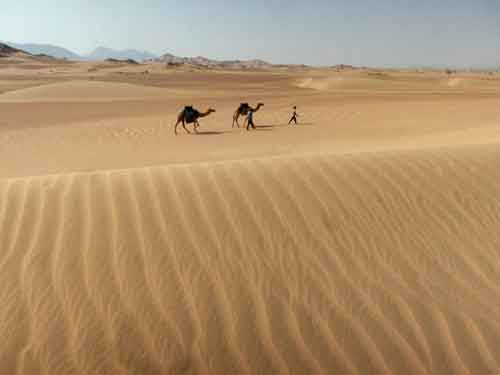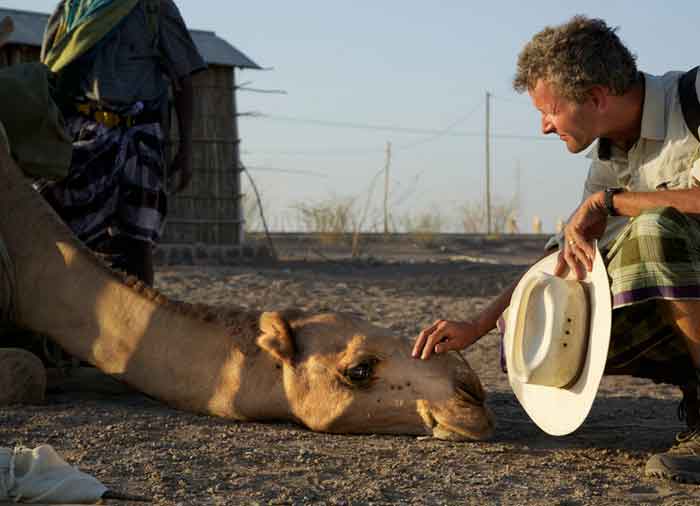By John Pint
 Several
years ago National Geographic Magazine published what struck me as an
absolutely astounding story. It stated that every single human being on
the face of the earth today is a descendant of a rather small number
(perhaps only a few hundred) people who emigrated out of Africa around
60,000 years ago, embarking on a trek that would quite literally take
them to the very ends of the earth. This conclusion was based on
advances in genetics and DNA samples taken worldwide. Several
years ago National Geographic Magazine published what struck me as an
absolutely astounding story. It stated that every single human being on
the face of the earth today is a descendant of a rather small number
(perhaps only a few hundred) people who emigrated out of Africa around
60,000 years ago, embarking on a trek that would quite literally take
them to the very ends of the earth. This conclusion was based on
advances in genetics and DNA samples taken worldwide.
The fact that we are all descended from Africans impressed me,
but I was especially interested in the fact that most of our ancestors
had crossed the Bab Al Mandeb Strait over to the Arabian Peninsula and
worked their way north through what is now Saudi Arabia.
This resonated with my own thirteen-year study of Saudi Arabia’s caves.
I knew that the principal sources for water and shelter (from heat,
cold and especially from wind) along vast stretches of western Arabia
are lava tubes: caves up to twenty kilometers long and 40 meters wide
which are located (sometimes in great numbers) among the 80,000 square
kilometers of lava fields near which many of those early forebears must
surely have passed. Umm Jirsan Cave and the runoff river at the edge of Harrat Khaybar most likely offered shelter and water to those early ancestors of ours.
National Geographic's map of mankind’s great migration must have impacted many people
around the globe, among them a man named Paul Salopek, one of the
world’s great journalists and two-time winner of the coveted Pulitzer
Prize. Salopek really took the story of humanity’s long walk to heart.
Following clues provided by DNA studies, he mapped out a route all the
way from Ethiopia to Patagonia—21,000 miles—and proposed to walk all
that distance (except for a couple short stretches over water) during
seven years of his life.
Why does he want to do this?
“Long-term storytelling,” he replied. “It’s not an athletic event… I
want to examine the great issues of our day at three miles an hour… to
watch the world around me and to get into people’s lives.”
Salopek started his journey in January, 2013, crossed the Red Sea and,
accompanied by a Bedu and two pack camels, slowly walked his way north
through Saudi Arabia, always talking to local people, listening to
their worries, hopes and dreams, and reporting short, fascinating
dispatches every few days.

A'urta
gets a reassuring head scratch while being loaded for the trail.
PHOTOGRAPH BY JOHN STANMEYER-VII
“I am on a journey,” he
says. “I am in pursuit of an idea, a story, a chimera, perhaps a folly.
I am chasing ghosts. Starting in humanity’s birthplace in the Great
Rift Valley of East Africa, I am retracing, on foot, the pathways of
the ancestors who first discovered the Earth at least 60,000 years ago.
This remains by far our greatest voyage.”
“We know so little about them… They straddled the strait called Bab el
Mandeb—the ‘gate of grief” that cleaves Africa from Arabia—and then
exploded, in just 2,500 generations, a geological heartbeat, to the
remotest habitable fringe of the globe.
Millennia behind, I follow.”
At the time of this writing, Paul Salopek is somewhere close
to Syria (not too close, I hope), having walked along the Red Sea coast through the ruins of Roman Therms and then past Jordan’s
Wadi Rum (through which Lawrence of Arabia sneaked up on the Turks) and
the famed Nabatean tombs of the once Lost City of Petra.
By now I hope you are thinking: here is
someone I ought to investigate on my own. Believe me, you’ll enjoy what you
find! As Ken Armstrong said in the Seattle Times:
“Paul doesn’t take shortcuts. To tell a story of
civil war, he took a five-week trip down the Congo River, mostly by
canoe. To tell a story of the people in Mexico’s Sierra Madre, he
traveled 1,300 miles by mule. He crosses mountain passes, deserts and
seas, all to tell us stories.”
Want to read some of those stories? Go to Out of
Eden Walk,
have a look at Paul Salopek’s latest dispatches, and if you like what
you see, sign up right there for regular email notifications of his
latest reports. In my opinion, you’re guaranteed six more years of
reading pleasure.
|

